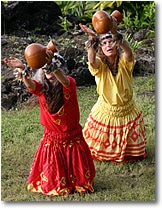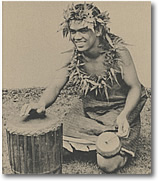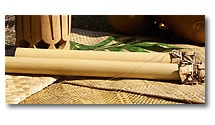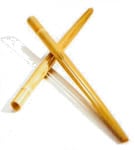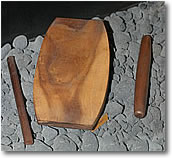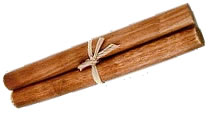Instruments
KA:
Beater, usually manufactured from sennit, banana bark, or ti leaf, and used to strike the head of the KILU.
PU:
Shell or other trumpets, usually blown to demand attention.
OEOE:
Whistle, traditionally made from a kamani seed or
coconut shell. These would have one or more holes cut in them to
produce sound, and be attached to a long cord. When a performer
twirled the cord, air rushing through the holes would produce sound.
HOKIO:
Small gourd whistles, somewhat like ocarinas
WI:
Shells of the freshwater snail Nerita granosa used as
whistles.
Implements:
Dancers employ implements to create sounds. Usually they will select implements in some way appropriate to the dance they are performing. For example, because Pele creates stones, `ili`ili often accompany dances in her honor. Dances about water may employ ipu, which Hawaiians once used as containers. Some of the traditional hula implements are:
`ULI`ULI:
Gourds filled with small shells, seeds, or pebbles. `Uli`uli have a handle attached to one end, and this handle usually is attached to a counterweight which may be covered with kapa, feathers, or both. Generally, but not always, people performing hula in the ancient manner will use a single `uli`uli decorated with natural feathers and tapa, or with an unadorned handle. Brightly dyed feathers usually cover the heads of `uli`uli used in modern style dances, and dancers will commonly perform with two of these implements.
`ILI`ILI:
Pebbles. Dancers will usually hold two of these in each hand and strike them against each other like castanets.
PAPAHEHI:
Treadle; a flat board on which a dancer would place one foot. By moving her/his foot up and down, s/he would create a base beat. Papa hehi were used to accompany certain hula kala`au.
An excellent source on how to make your own Hawaiian musical instrument is the book called “HOW TO MAKE YOUR OWN HAWAIIAN MUSICAL INSTRUMENTS” by Jerry Hopkins, ISBN: 0-935848-66-5



